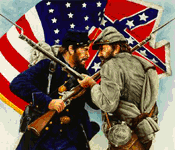 |
Civil War Battles |
|
State War Records |
| AL - AK - AZ - AR - CA - CO - CT - DE - FL - GA - HI - ID - IL - IN - IA - KS - KY - LA - MA - MD - ME - MI - MN - MS - MO - MT - NE - NV - NH - NJ - NM - NY - NC - ND - OH - OK - OR - PA - RI - SC - SD - TN - TX - UT - VT - VA - WA - WV - WI - WY |
The Battle of Tuscaloosa
April 3-4, 1865 in Tuscaloosa, Alabama
 |
|||||||||||||||||||||
|
After fording the flooded Black Warrior River in the area of Johnson’s Ferry, Brig. Gen. John T. Croxton’s force headed south along the Watermelon Road towards Northport. The road from Northport into Tuscaloosa went over an old covered bridge, which was guarded by 6 members of the Tuscaloosa Home Guard.
On the night of April 3, upon seeing the approaching Union cavalry, the guards removed parts of the bridge’s wooden plank floor. After a minor skirmish in which the Home Guard’s leader, Capt. Benjamin Eddins was killed, elements of the 2nd Michigan Cavalry repaired the bridge and prepared for the arrival of Croxton’s main force.
After entering Tuscaloosa, the Union troops immediately set fire to a hat factory, which was considered a military target since it provided hats for the Confederate Army. Furthermore, the town’s only 3 cannons, which were to be used by University of Alabama cadets for defense of the town, were discovered hidden in a stable and captured. Union troops also destroyed and looted several stores and the local Confederate government bank.
In response to the Union force which had entered Tuscaloosa, the University of Alabama commandant Col. James T. Murfee called up the 300 strong University Corps of Cadets. The cadets formed in front of the Rotunda, on the site near the present day Gorgas Library. Armed only with outdated Springfield rifles, the cadets were immediately dispatched to engage the Union troops. They met in the area near present day Tuscaloosa City Hall, although contemporary sources conflict on the exact site of the skirmish.
The cadets formed a defensive line in the street, which was perhaps in the area of Greensboro Avenue. After sending forward a group of pickets, the young cadets encountered Croxton’s 6th Kentucky Cavalry. After bravely firing the initial volley, the University cadets were immediately met by fierce counter fire and forced to withdraw back to the University of Alabama campus. Here they gathered what supplies they could, and left Tuscaloosa by way of the Huntsville Road and headed south. They eventually arrived at Marion on March 8 and were disbanded.
By the early morning of April 4, the main portion of Croxton’s force had entered Tuscaloosa. Union forces under Col. Johnston arrived at the University of Alabama with orders from Croxton to destroy all public buildings. This included the Rotunda, which housed the main library. The other university buildings included the Observatory, Washington Hall, Franklin Hall, Jefferson Hall, a guard house, dormitories, powder magazine, the President’s Mansion, and Steward Hall. In spite of the pleading of the university’s faculty not to destroy the library, Croxton confirmed his order to destroy all public buildings. Additionally, a platoon of Union troops went into the Alabama Insane Hospital, but left the building undisturbed. Another platoon of Union troops began to sack the President’s Mansion, but stopped because of the pleading of the university president’s wife. However, the Rotunda and other main buildings were burned to the ground. The only buildings to survive the massive fire were the President’s Mansion, Gorgas House, Observatory, and Round House. The most tragic loss was the destruction of a large portion of the university’s library holdings.
Along with the destruction of the University of Alabama, Croxton destroyed Tuscaloosa’s iron foundry, which had been used for small caliber cannon production. Union forces also destroyed a nitre works and cotton mill.
